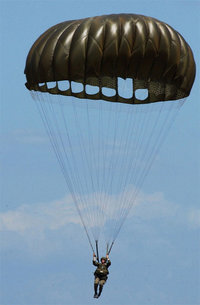Paratrooper
|
|
| Contents |
Types of Military Parachuting
In World War II paratroopers most often used parachute of a round design. These parachutes could be manipulated in a minimal way by pulling on the risers, a strap connecting the paratroopers harness to the connectors and suspension lines which attach to the parachute canopy itself. German paratroopers, whose harnesses which much more like a sling were not manipulated in such a manner. Due to the limited capacity of period cargo aircraft they rarely if ever jumped in groups much larger than 20 from one aircraft. In American parlance, this load of paratroopers was called a "stick."
Today, paratroopers still use round parachutes, or round parachutes modified as to be more fully controlled with toggles and deployed by use of a static line. Due to the fact these are used en masse and at low altitude, mobility is purposely low as to limit collisions and prevent the scattering of a unit. Some military exhibition units, but most often special operations units, use "ram-air" wings which offer higher ability to turn and maneuver and are deployed without a static line from high altitude. In the American military any load of soldiers gathered for air movement is known as a "chalk."
Paratroopers forces around the world
- Israeli Defence Forces - Paratroopers Brigade
- Italian Army - Paratroops Brigade "Folgore"
- British Army - The Parachute Regiment
- United States Army - 82nd Airborne Division
- United States Army - 101st Airborne Division Now Airmobile
See also:
Basic Paratroop Safety
American paratroopers receive training in a number of areas to ensure they have a safe jump. They are taught about how to respond to a premature deployment of their parachute in the aircraft, the need to push their static line into the hands of the safety or jumpmaster to prevent the line from becoming entangled around the next jumper and proper procedures in case the aircraft has an emergency. The five points of performance, a system of steps taught to paratroopers to be performed while jumping in order to successfully reach the ground from the aircraft, are also observed. Trained in such a way as to be automatic steps taken after exiting the aircraft, they ensure that a paratrooper wastes as little time as possible if the paratrooper must open their reserve chute. The first is proper exit, check body position and count. Proper body position is to ensure the jumper does not tumble out of the aircraft, making it less likely that the parachute will deploy and become entangled. A long count to four ensures that the jumper gives their chute adequate time to deploy and if opening shock is not felt they begin the procedure for deploying their reserve parachute. The second point, check canopy and gain canopy control, ensures that when the parachute deploys there are no defects, which may force the jumper to deploy their reserve parachute. Gaining canopy control allows the jumper to make proper corrections during descent. The third point, keeping a watch for all jumpers during the entire descent is intended to prevent collisions or "theft" of air. Jumpers are taught the three Rules of the Air as a portion of this point of performance, they are: Always look before you turn, turn right to avoid collisions and the lower jumper has the right of way. The fourth point is slip and turn into the wind and prepare for landing. This step is taken in order to further maximize control of descent, and decrease speed of travel in relation to horizontal motion across the ground. Additionally, at no lower than 200 feet above the ground the jumper releases their equipment in order to not become entangled with other jumpers or collapse their canopy. Finally the fifth point of performance is landing, during which a jumper executes a proper Parachute Landing Fall, a means of using motion to transfer the force of impact when hitting the ground and ensuring the parachute is given adequate conditions to collapse after landing. The jumper is taught to release at least one release latch on their harness to fully collapse the chute and prevent being dragged across the ground.
History
For a history of paratroop forces see Airborne forces.

